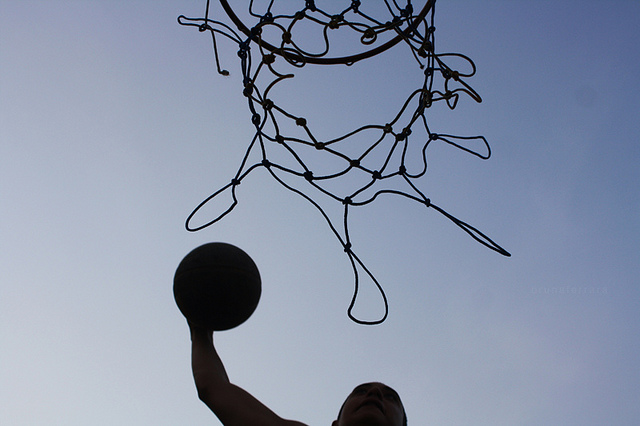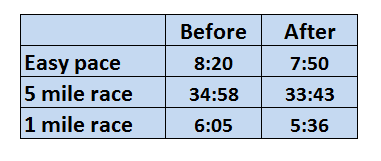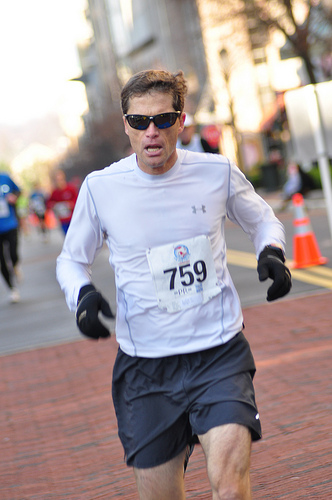Making the transition from a team sport athlete to a runner can be tough. I know, I used to be a basketball player.
When I stopped growing at 5’7″, my dreams of dunking an alley-ooped basketball died faster than I did at the NYC Marathon (too soon?).

This is me – on a 7 foot hoop.
Like me, Andy used to be a team sport athlete. He’s a 48 year old former soccer player who continued playing after high school and college.
After several decades, he lost the joy he once felt: his opponents were 15 years younger, his favorite teammates had moved on, and he was consistently injured. It was time to let go.
So he did what a lot of athletes do: he joined a local running program, entered a few races, and began embracing the sport of distance running.
Alas, the injuries started cropping back up almost immediately. Eager to embrace his new passion, Andy says:
“I had read that running hills was good for building speed and so, feeling my oats, went grinding up some steep hills. When the pain started, I figured it was just the muscle working hard and kept going. When the muscle totally seized, I hobbled home. It took about 8 weeks, including a doctor’s visit and prescribed physical therapy, to be able to run again.”
Ouch. Soon after, Andy discovered Strength Running and was interested in dropping his 5k personal best. It was about the time that the Rebel Running Guide was published, so he picked up a copy and was eager to start training again.
[Note: this program is no longer available. If you’d like to run a fast 5k, learn more about my custom training plans here.]
“There is no doubt that my wife noticed my enhanced muscle tone”
Andy dove into the Elite 5k training plan. He lives near Rock Creek Park in Washington, DC so he did many of his runs on the same dirt trails that I run my workouts on. He loved it.
“The best long run was with my 8 year-old daughter one Sunday morning – she on her bike and me running, the angled sun keeping us warm in the crisp fall air. Her pace matched mine and we chatted as we went along, looking at the ducks, geese and dogs. A happy day for dad, for sure,” Andy remembered.
He said he felt smoother and lighter on his feet during his fartlek workouts – even more so than his regular runs. A big part of the Rebel Running Guide is balancing easy running with 5k specific workouts that are designed to get you faster while making the training fun.
But that’s not all that you get in the RRG.
“It wasn’t just the runs that I enjoyed,” Andy said. “I particularly liked the core workouts. I could feel my strength and posture improving and there is no doubt that my wife noticed my enhanced muscle tone… When I had a couple of weeks when I let the workouts slip due to a pressing work schedule, my hamstrings and calves started to hurt again. Good stuff, those core workouts.”
“Best of all, not only did I have fun – I got faster”
Having fun while training is an important goal for many runners. But many of us also want to get fast! Andy was able to do both.
Let’s take a look at how he progressed from before the Rebel Running Guide to afterward:

Not bad! But the Rebel Running Guide is a program for runners who want to get faster in a 5k. So how did Andy do?
He ran two 5k races at the end of his training. The first one was a disappointment.
He got to the race with only 40 minutes to get his race packet and warm up. After a few dynamic stretches, he ran about a mile but wasn’t able to run any strides before the gun. Andy remembers, “When the race started, I was still re-tying my shoe. It didn’t take long for me to wish I’d had more of a warm-up.”

Likely because of his short warm-up, his left hamstring got tight during the race. Luckily it loosened up and he crossed the finish line in 20:47 – still 7 seconds faster than before the Rebel Running Guide.
But Andy was disappointed. He said, “I was ticked. I could have – should have – done better. Besides not warming up enough, I didn’t push myself hard enough, it was a mental thing. I felt like I let myself down after all the work I’d done.”
So did Andy give up? Did he blame the program or his age or the short warm-up or a thousand other things he could have leaned on as excuses?
Hell no.
Andy still wanted to kick ass and prove to himself that he was faster. So he signed up for another race and got down to business.
On race day, he hit traffic due to construction. The Running Gods were definitely conspiring against him. But this time, Andy didn’t check out mentally; he was determined to prove to himself that he had a better 5k in him.
So he decided to run hard from the start of the race. He went out a bit too quickly in 6:09, but then settled into a more relaxed pace. He felt good throughout the race and increased his effort over the last half-mile.
He crossed the finish line in 20:13 – 34 seconds than before the program. That’s huge! He was also 5th overall and first in his age group.
Andy remembers, “I managed to push myself a bit—and improve a good chunk on the 20:54 I ran just before starting the Rebel Running program.”
You Can Improve Like Andy, Too
Andy is a big success story. While I’d love to say that the Rebel Running Guide is the reason why, it’s really because of his hard work over a few months.
He learned some valuable lessons on his journey. In his own words, this is what helped him accomplish a 40+ second PR in the 5k:
- Don’t slack off on the non-run workouts (You feel and look better when you stick to the workouts).
- Always work on race pacing.
- Being fit is important. Being mentally tough is too!
- You can’t leave too early for a race.
These are good lessons and unfortunately, Andy had to learn some of them the hard way. I feel like a broken record sometimes, but core strength and the “little things” really do make a difference!
And let’s not forget the mental aspect of racing. My favorite quote on this is:
“Long distance running is 90% mental and the other half is physical.” – Rich Davis
Staying mentally tough in a race is all about confidence and believing that the hard work you’ve done in training has prepared you to race. You did the work – now reap the rewards.
The other two big parts of Andy’s success include the fact that he had a plan to follow and that he remembered to keep things fun.
Running can be boring at times – let’s admit it – so you need a structured plan or else you may just wind up running the same thing day after day. If you do that, you’ll never improve.
You’ll also get bored as hell. The goal with the Rebel Running Guide is to make running fun and to keep you engaged with your workouts. Andy said, “Thanks for the Rebel Running Guide. It was a great read (tight, punchy, informative and entertaining) and gave me the structure and tools I needed.
“I’m looking forward to the next ten weeks – so much so that I actually bought my first pair of running tights. Now that’s a huge step for a soccer guy.” Big step indeed! Just wait until you have 4 pairs of them like I do…
Thanks Andy for sharing your story! Congratulations on the big improvement – it’s always awesome to hear this kind of success!
Want to experience your own success? Get your own training program!